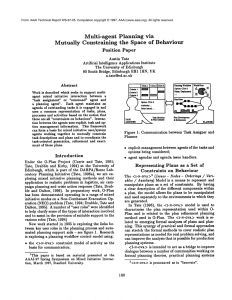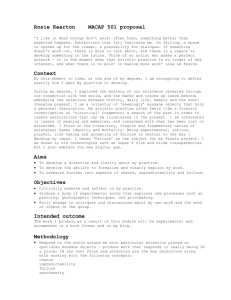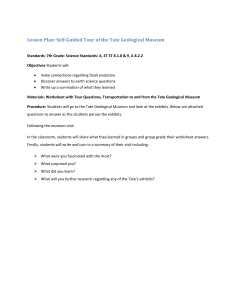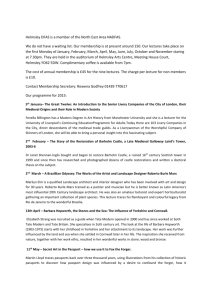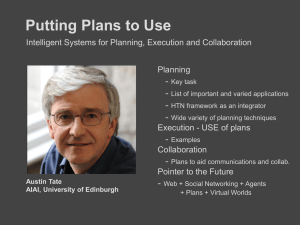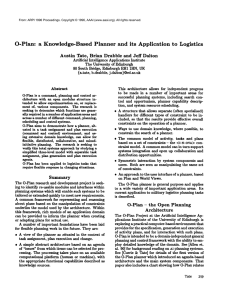Proceedings Template - WORD - AIAI
advertisement
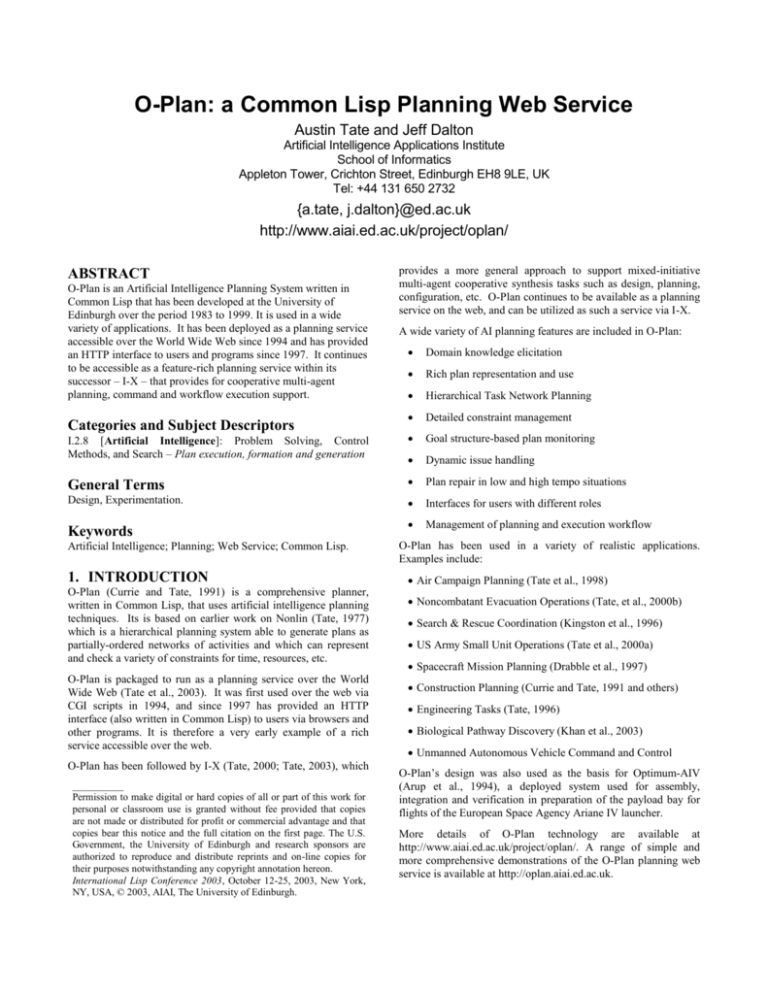
O-Plan: a Common Lisp Planning Web Service
Austin Tate and Jeff Dalton
Artificial Intelligence Applications Institute
School of Informatics
Appleton Tower, Crichton Street, Edinburgh EH8 9LE, UK
Tel: +44 131 650 2732
{a.tate, j.dalton}@ed.ac.uk
http://www.aiai.ed.ac.uk/project/oplan/
ABSTRACT
O-Plan is an Artificial Intelligence Planning System written in
Common Lisp that has been developed at the University of
Edinburgh over the period 1983 to 1999. It is used in a wide
variety of applications. It has been deployed as a planning service
accessible over the World Wide Web since 1994 and has provided
an HTTP interface to users and programs since 1997. It continues
to be accessible as a feature-rich planning service within its
successor – I-X – that provides for cooperative multi-agent
planning, command and workflow execution support.
provides a more general approach to support mixed-initiative
multi-agent cooperative synthesis tasks such as design, planning,
configuration, etc. O-Plan continues to be available as a planning
service on the web, and can be utilized as such a service via I-X.
A wide variety of AI planning features are included in O-Plan:
Domain knowledge elicitation
Rich plan representation and use
Hierarchical Task Network Planning
Detailed constraint management
I.2.8 [Artificial Intelligence]: Problem Solving, Control
Methods, and Search – Plan execution, formation and generation
Goal structure-based plan monitoring
Dynamic issue handling
General Terms
Plan repair in low and high tempo situations
Design, Experimentation.
Interfaces for users with different roles
Management of planning and execution workflow
Categories and Subject Descriptors
Keywords
Artificial Intelligence; Planning; Web Service; Common Lisp.
1. INTRODUCTION
O-Plan (Currie and Tate, 1991) is a comprehensive planner,
written in Common Lisp, that uses artificial intelligence planning
techniques. Its is based on earlier work on Nonlin (Tate, 1977)
which is a hierarchical planning system able to generate plans as
partially-ordered networks of activities and which can represent
and check a variety of constraints for time, resources, etc.
O-Plan is packaged to run as a planning service over the World
Wide Web (Tate et al., 2003). It was first used over the web via
CGI scripts in 1994, and since 1997 has provided an HTTP
interface (also written in Common Lisp) to users via browsers and
other programs. It is therefore a very early example of a rich
service accessible over the web.
O-Plan has been followed by I-X (Tate, 2000; Tate, 2003), which
__________
Permission to make digital or hard copies of all or part of this work for
personal or classroom use is granted without fee provided that copies
are not made or distributed for profit or commercial advantage and that
copies bear this notice and the full citation on the first page. The U.S.
Government, the University of Edinburgh and research sponsors are
authorized to reproduce and distribute reprints and on-line copies for
their purposes notwithstanding any copyright annotation hereon.
International Lisp Conference 2003, October 12-25, 2003, New York,
NY, USA, © 2003, AIAI, The University of Edinburgh.
O-Plan has been used in a variety of realistic applications.
Examples include:
Air Campaign Planning (Tate et al., 1998)
Noncombatant Evacuation Operations (Tate, et al., 2000b)
Search & Rescue Coordination (Kingston et al., 1996)
US Army Small Unit Operations (Tate et al., 2000a)
Spacecraft Mission Planning (Drabble et al., 1997)
Construction Planning (Currie and Tate, 1991 and others)
Engineering Tasks (Tate, 1996)
Biological Pathway Discovery (Khan et al., 2003)
Unmanned Autonomous Vehicle Command and Control
O-Plan’s design was also used as the basis for Optimum-AIV
(Arup et al., 1994), a deployed system used for assembly,
integration and verification in preparation of the payload bay for
flights of the European Space Agency Ariane IV launcher.
More details of O-Plan technology are available at
http://www.aiai.ed.ac.uk/project/oplan/. A range of simple and
more comprehensive demonstrations of the O-Plan planning web
service is available at http://oplan.aiai.ed.ac.uk.
2. SIMPLE PLANNING SERVICES
One example of a simple application of the O-Plan Planning Web
Service is to provide a Unix Systems Administrators Script
writing aid. This shows a very simple packaged use of planning
technology accessible over the web. A form can be filled in
stating the requirements on mapping physical to logical Unix disk
volumes. The planner can generate a suitable script for this task.
The maintenance of such scripts in Unix was proving problematic
for a Unix system vendor to maintain. The application shows how
AI planning can be used in cases where the basic ingredients used
are not very numerous, but the way they can be combined varies.
Other simple “single-shot” plan generation applications often use
a similar type of form-filling style of interface on the web.
Figure 1. O-Plan generating a Unix system script.
SUO application uses O-Plan running as a web service with a
course of action/evaluation matrix process panel interface (Tate et
al., 2000b) and addresses all the phases of a small unit operation.,
and the whole lifecycle of the generation and use of plans:
Domain and initial plan representation
Deliberative initial planning and generation of multiple
options
Plan execution monitoring and dynamic repair of plans
Tailored interfaces for various user roles including process
and workflow support.
Figure 2. O-Plan with multiple cooperating web users.
.
3. MULTI-USER PLANNING
SERVICES
4. OPEN PLANNING. ARCHITECTURE
A more comprehensive web interface is available for the O-Plan
planning service that provides a table with columns showing
options for various Courses of Action (COAs) and rows showing
both the process steps involved in generating the plans and a set
of evaluations of the plan options. This matrix interface can be
used in a generic form but also has specialized versions for
particular applications, such as one that creates plans for disaster
recovery and emergency response. The interface allows multiple
users in different roles to work with O-Plan in a mixed-initiative
fashion. User roles can be as commander/task assigner or planner.
The resulting “Open Planning Process Panel” (O-P3) (Tate et al.
1999; Levine et al., 2000) supports the coordination of the
planning process between users and the automated planning agent
in the development of multiple options at various stages of
generation and evaluation.
An important property of the O-Plan design, and one that is
greatly facilitated by Lisp, is that O-Plan is a framework that
allows key components to be plugged in. O-Plan finds a plan by
exploring a search space of partial plans. “Issues” represent the
missing parts of a partial plan. These say, for instance, that an
action has not yet been expanded into subactions or that a
condition needs to be satisfied. O-Plan's top level is a controller
that repeatedly selects an issue and invokes a "knowledge source"
(also known as an "issue handler") that is able to resolve that type
of issue, until either no issues remain or the remaining issues are
ones O-Plan has not been authorized to handle.
In work with the US Army we have identified the stages in the
overall Small Unit Operations (SUO) command, planning and
execution process at US Army company level, from receipt of
mission through to a successful outcome and after-action activities
(US Army, 1999). Within this process there are opportunities for a
range of planning and decision aids, all facilitated by a common
approach to representing the objectives and plans involved. The
Knowledge sources can make decisions about what to put in the
plan and what parts of the search space to visit. They build a plan
by adding nodes to a partially ordered network of actions and by
adding constraints that represent pre- and post-conditions on
actions, time limitations, resource usage, and other things.
Constraint managers determine whether constraints can be
satisfied in the plan and can tell knowledge sources of possible
ways to satisfy them.
This is implemented in a way that allows knowledge sources and
constraint managers to be added as desired, and indeed for the
entire set of knowledge sources and constraint managers to be
replaced. In that way, the same architecture and controller can be,
and have been, adapted to tasks other than planning - tasks such
as plan execution monitoring (Reece and Tate, 1994) and
scheduling (Beck and Tate, 1995).
annotation hereon. The views and conclusions contained herein
are those of the authors and should not be interpreted as
necessarily representing the official policies or endorsements,
either express or implied, of other parties.
Other types of pluggable component are plan evaluators, plan and
world-state viewers, plan "sanity checkers", and, when O-Plan is
used over the Web, handlers for HTTP requests.
7. SUMMARY
Plug-ins can be as simple as defining a function and registering it
with the appropriate part of the system. For instance, knowledge
sources are registered with the controller and constraint managers
with a database manager.
Other cases are more complex. A constraint manager is a CLOS
object, and there are a number of mixin classes that allow simpler
managers to be written. It is also possible to define the syntax of
a new type of constraint by adding a constraint parser to the
recursive-descent parser for O-Plan's Task Formalism (TF)
language (Tate, et al., 1998)
5. PLAN OPTIONS
An option is a point in O-Plan’s search space (and hence is a
partial plan) that has been given a name to allow an external agent
to refer to that point while using O-Plan. This is what allows the
matrix interface to manage a number of different plans, and for the
user to switch freely between them. The user can add new actions
to a plan, add constraints, or give O-Plan the authority to expand
the plan to deeper levels of subactions. An option can also be
split into two children, so that they can be developed in different
ways. Moreover, it is possible to simulate the execution of one
plan while still developing others.
Options are another feature that has been greatly facilitated by
Lisp. They are implemented using a context layering mechanism
that adds an extra, implicit parameter - the current context - to
object accessors (Tate, 1984)1. Contexts form a tree, with a child
seeing by default the same values as its parent. When O-Plan has
to choose between different ways to resolve an issue while
developing a plan, it moves to a new child context, saving the
parent as a backup point, so that it can later return and try one of
the other possibilities. Thus each partial plan that O-Plan develops
corresponds to a context, and options are in effect tags on some of
those contexts. Lisp macros make it easy to define accessor
functions that use contexts without writing out the code each time,
and in Lisp the resulting functions look the same to callers as
ordinary accessors. The current context is the value of a
dynamically scoped variable, making it easy to change contexts.
O-Plan is a feature-rich artificial intelligence planning system
written in Common Lisp and packaged to be available as a service
over the World Wide Web. Its facilities cover the whole spectrum
of initial planning domain knowledge modelling, through
refinement of an initial outline plan or set of requirements to
generate any of a number of options to meet those objectives, to
the monitoring of the execution of a plan, and its repair where
needed to cope with a dynamically changing environment.
8. REFERENCES
[1] Aarup, M., Arentoft, M.M., Parrod, Y., Stokes, I., Vadon, H.
and Stader, J. (1994) Optimum-AIV: A Knowledge-Based
Planning and Scheduling System for Spacecraft AIV, in
Intelligent Scheduling (eds. Zweben, M. and Fox, M.S.), pp.
451-469, Morgan Kaufmann.
[2] Beck, H. and Tate, A. (1995) Open Planning, Scheduling and
Constraint Management Architectures, in the British
Telecommunication's Technical Journal, Special Issue on
Resource Management, 1995.
[3] Currie, K.W. and Tate, A. (1991) O-Plan: the Open Planning
Architecture. Artificial Intelligence 52(1), Autumn 1991,
North-Holland.
[4] Drabble, B., Dalton, J. and Tate, A. (1997) Repairing Plans
On-the-Fly, in Proceedings of the NASA Workshop on
Planning and Scheduling for Space, Oxnard CA, USA,
October 1997.
[5] Khan, S., Decker, K., Gillis, W. and Schmidt, C (2003) A
Multi-Agent System-driven AI Planning Approach to
Biological Pathway Discovery, Proceedings of the Thirteenth
International Conference on Automated Planning and
Scheduling (ICAPS 2003) (eds. Giunchiglia, E., Muscettola,
N., and Nau, D), Trento, Italy, June 9-13, 2003. AAAI Press.
[6] Kingston, J., Shadbolt, N. and Tate, A. (1996),
CommonKADS Models for Knowledge Based Planning, in
Proceedings of the National Conference on Artificial
Intelligence (AAAI-96), Portland, Oregon, USA, August
1996.
[7] Levine, J., Tate, A. and Dalton, J. (2000) O-P3: Supporting
6. ACKNOWLEDGMENTS
This material is based on research within the O-Plan and I-X
projects sponsored by the Defense Advanced Research Projects
Agency (DARPA) and US Air Force Research Laboratory under
agreement number F30602-03-2-0014 and earlier contracts. The
U.S. Government, the University of Edinburgh and research
sponsors are authorized to reproduce and distribute reprints and
on-line copies for their purposes notwithstanding any copyright
1
The mechanism and algorithms used in O-Plan’s context
structures was later adapted by USC/ISI for use in the
context/worlds facility of LOOM.
the Planning Process using Open Planning Process Panels.,
IEEE Intelligent Systems, Vol. 15, No. 6,
November/December 2000.
[8] Potter, S., Tate, A. and Dalton, J. (2003) I-X: Task Support
on the Semantic Web, Poster Abstract, Second International
Semantic Web Conference (ISWC-2003), Sanibel Island,
Florida, October 2003.
[9] Reece, G. and Tate, A. (1994) Synthesizing Protection
Monitors from Causal Structure, in the Proceedings of the
Second International Conference on Planning Systems
(AIPS-94), Chicago, June 1994, AAAI Press.
[10] Tate, A. (1977) Generating Project Networks, Proceedings of
the International Joint Conference on Artificial Intelligence
(IJCAI-77), pp. 888-893, Cambridge, MA, USA, Morgan
Kaufmann.
[11] Tate, A. (1984) Functions in Context Database, Second
Alvey Workshop on Large Knowledge Base Architectures,
Manchester, UK, July 1984, Also AIAI-TR-1, Artificial
Intelligence Applications Institute, University of Edinburgh.
[12] Tate, A., Polyak, S. and Jarvis, P. (1998) TF Method: An
Initial Framework for Modelling and Analysing Planning
Domains. Workshop on Knowledge Engineering and
Acquisition at the Fourth International Conference on AI
Planning Systems (AIPS-98), Carnegie-Mellon University,
Pittsburgh, PA, USA, June 1998.
[13] Tate, A. (2000) Intelligible AI Planning, in Research and
Development in Intelligent Systems XVII, Proceedings of
ES2000, The Twentieth British Computer Society Special
Group on Expert Systems International Conference on
Knowledge Based Systems and Applied Artificial
Intelligence, pp. 3-16, Cambridge, UK, December 2000,
Springer.
[14] Tate, A. (2003) Coalition Task Support using I-X and
<I-N-C-A>, in Proceedings of the 3rd International Central
and Eastern European Conference on Multi-Agent Systems
(CEEMAAS 2003), Prague, Czech Republic, 16-18th June
2003, pp.7-16, Springer Lecture Notes in Artificial
Intelligence LNAI 2691.
[15] Tate, A., Levine, J., Jarvis, P. and Dalton, J. (2000) Using AI
Planning Technology for Army Small Unit Operations,
Poster Paper in Proceedings of the Fifth International
Conference on Planning and Scheduling Systems (AIPS2000), Breckenridge, Colorado, USA, April 2000.
[16] Tate, A., Drabble, B. and Dalton, J. (1996) O-Plan: a
Knowledge-Based Planner and its Application to Logistics,
in Advanced Planning Technology (ed. Tate, A.), Morgan
Kaufmann, May 1996.
[17] Tate, A. (1996) Responsive Planning and Scheduling Using
AI Planning Techniques - Optimum-AIV, in "Trends &
Controversies - AI Planning Systems in the Real World",
IEEE Expert: Intelligent Systems & their Applications, Vol.
11 No. 6, pp. 4-12, December 1996.
[18] Tate, A., Dalton, J. and Levine, J. (1998) Generation of
Multiple Qualitatively Different Plan Options, in
Proceedings of the Fourth International Conference on
Artificial Intelligence Planning Systems (AIPS-98),
Pittsburgh PA, USA, June 1998
[19] Tate, A., Levine, J., Dalton, J., and Aitken, S. (1999) O-P3:
Supporting the Planning Process using Open Planning
Process Panels, in Proceedings of the AAAI Workshop on
Agent Based Systems in the Business Context, AAAI-Press
WS-99-02.
[20] Tate, A., Levine, J., Jarvis, P. and Dalton, J. (2000a) Using
AI Planning Techniques for Army Small Unit Operations,
Poster Paper in the Proceedings of the Fifth International
Conference on AI Planning and Scheduling Systems (AIPS2000), Breckenridge, CO, USA, April 2000.
[21] Tate, A., Dalton, J. and Levine, J. (2000b) O-Plan: a Webbased AI Planning Agent, AAAI-2000 Intelligent Systems
Demonstrator, in Proceedings of the National Conference of
the American Association of Artificial Intelligence (AAAI2000), Austin, Texas, USA, August 2000.
[22] Tate, A., Levine, J., Dalton, J. and Nixon, A. (2003) Task
Achieving Agents on the World Wide Web, in Spinning the
Semantic Web, Fensel, D., Hendler, J., Liebermann, H. and
Wahlster, W. (eds.), Chapter 15, pp. 431-458, MIT Press,
2003.
[23] US Army (1999) Center for Army Lessons Learned, Virtual
Research Library, http://call.army.mil
